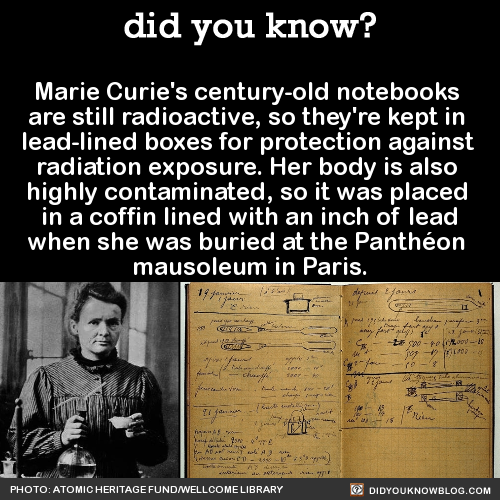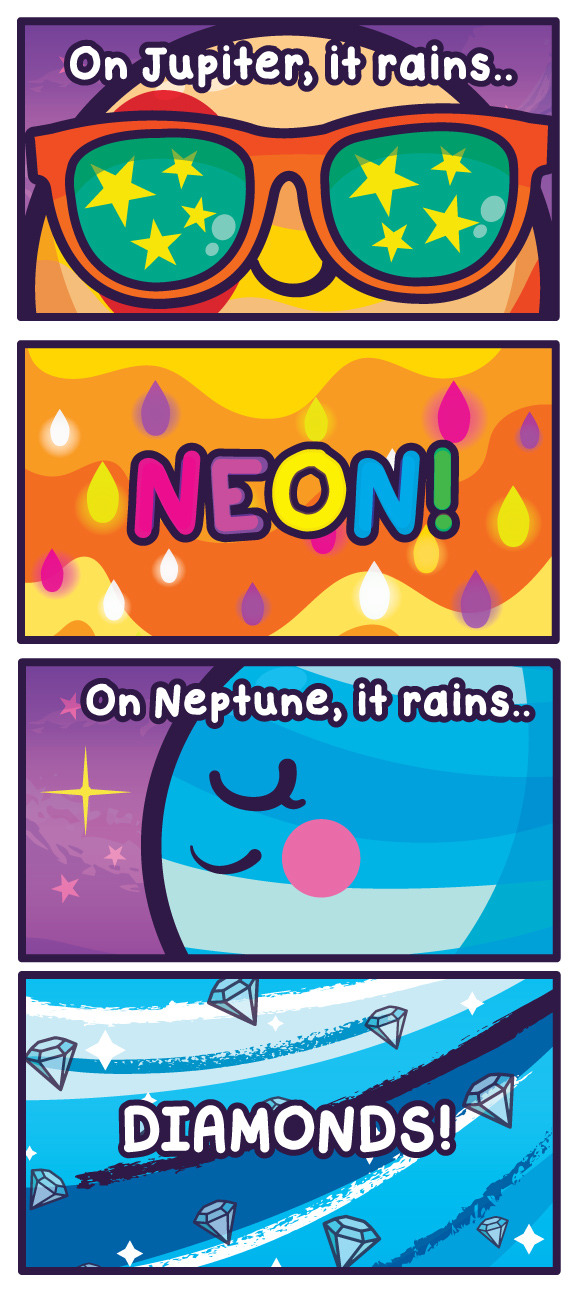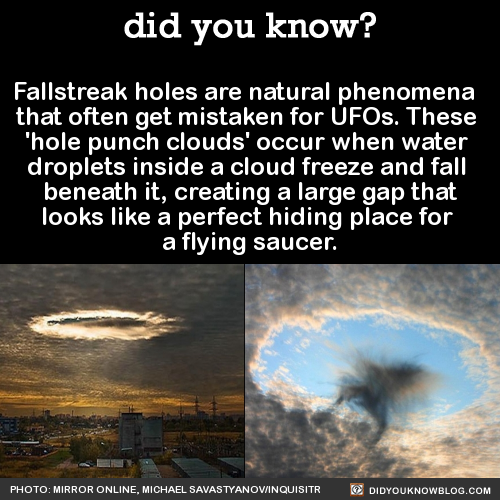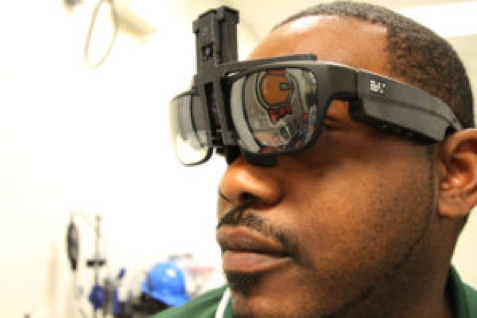thestarblaster-blog
Here I have things and stuff I like. I'm 18 years old pup who loves space and sciece. You may find some fascinating things here.
41 posts
Latest Posts by thestarblaster-blog

There’s a biological reason why we can’t resist puppy dog eyes. Sustained eye contact significantly raises oxytocin levels in both humans and dogs, which encourages love, trust, and bonding. This response isn’t even found in hand- raised wolves, which suggests humans and dogs may have co-evolved to share this trait in order to be companions. Source Source 2 Source 3



Marie Curie’s century-old notebooks are still radioactive, so they’re kept in lead-lined boxes for protection against radiation exposure.

Photo via: Wellcome Library, London
Anyone wishing to handle her notebooks, personal effects, or other items have to wear protective gear and sign a liability waiver, just in case. She basically walked around carrying radium and polonium in her pockets, so… yeah.

Photo via: Amanda Macias/Business Insider
Marie and her husband Pierre are buried in Paris’s Panthéon, a mausoleum in that contains the remains of distinguished French citizens — including philosophers Rousseau and Voltaire.
Source


If a person has experienced just one episode of depression in their lifetime, there’s a 50% chance they will have a second. If that happens, they become 80% more likely to endure it a third time. Source

Some meteors from the Geminid Meteor shower in Banff, Alberta
js

A group of Scandinavians built a replica of a Viking ship from scratch using only technology that would have been available at the time, then set sail from Norway to the US to prove the Vikings could have easily made the trip 500 years before Columbus did. Source Source 2 Source 3

I have a question for you
Why is christian god just God? I mean every other god have a name and a title.
Thor the god of storms and protector of mankind.
Odin the all father and death.
Shiva the god of creation, destruction and regeneration.
Ganesha the god of new beginnings and obstacle remover.
Zeus the god of sky, law and justice.
Apollo the god of music, plague and knowledge.
And all the others.

Paris syndrome is a mental disorder experienced mostly by Japanese tourists who are disappointed when they visit the city for the first time. The shock of Paris not living up to their expectations can cause depression, sweating, anxiety, dizziness, hallucinations and delusions of persecution. The Japanese Embassy in Paris has a 24-hour hotline for those needing help, and up to 20 tourists a year are hospitalized. The usual treatment for Paris syndrome is ‘to go home.’ Source Source 2 Source 3
The Moon Just Photobombed NASA’s Solar Dynamics Observatory
On May 25, 2017, the moon photobombed one of our sun-watching satellites by passing directly between the satellite and the sun.

The Solar Dynamics Observatory, or SDO, orbits Earth and watches the sun nearly 24/7 — except when another body, like the moon, gets in the way. These lunar photobombs are called transits, the generic term for when any celestial body passes in front of another.
Transits are one way we detect distant worlds. When a planet in another star system passes in front of its host star, it blocks some of the star’s light so the star appears slightly dimmer. By monitoring changes in a star’s light over time, scientists can deduce the presence of a planet, and even determine what its atmosphere is like. This method has been used to discover thousands of planets, including the TRAPPIST-1 planets.

SDO sees lunar transits about twice a year, and this one lasted about an hour with the moon covering about 89 percent of the sun at the peak of its journey across the sun’s face.
When they’re seen from Earth, we call lunar transits by another name: eclipses.

Solar eclipses are just a special kind of transit where the moon blocks all or part of our view of the sun. Since SDO’s view of the sun was only partially blocked, it saw a partial eclipse. Later this year, on Aug. 21, a total eclipse will be observable from the ground: The moon will completely block the sun’s face in some parts of the US, creating a total solar eclipse on a 70-mile-wide stretch of land, called the path of totality, that runs from Oregon to South Carolina.
Throughout the rest of North America — and even in parts of South America, Africa, Europe and Asia — the moon will partially obscure the sun, creating a partial eclipse. SDO will also witness this partial eclipse.

Total solar eclipses are incredible, cosmic coincidences: The sun is about 400 times wider than the moon, but it also happens to be 400 times farther away, so the sun and moon appear to be the same size in our sky. This allows the moon to completely block the sun when they line up just right.

Within the path of totality, the moon completely obscures the sun’s bright face, revealing the comparatively faint corona — the sun’s pearly-white outer atmosphere.

It’s essential to observe eye safety during an eclipse. You must use proper eclipse glasses or an indirect viewing method when any part of the sun’s surface is exposed, whether during the partial phases of an eclipse, or just on a regular day. If you’re in the path of totality, you may look at the eclipse ONLY during the brief moments of totality.

A total solar eclipse is one of nature’s most awe-inspiring sights, so make your plans now for August 21! You’ll also be able to see the eclipse cross the country that day through the eyes of NASA – including views of the partial eclipse from SDO – on NASA TV and at nasa.gov.
Learn more about the August eclipse — including where, when, and how to safely see it — at eclipse2017.nasa.gov and follow along on Twitter @NASASun.

I wasn’t aware how introvert I’ve come with my depression. I’ve never being good at talking on the phone, but today when I should’ve made a phone call to the bank, I panicked over a word that I forgot and hang up before I even get to the line.



The last but not least of Assorted Planets Month!
And now to cool you all off with some “refreshing” rain!
This week’s entry: Planetary Rain
http://www.zmescience.com/other/science-abc/rain-titan-earth-neptune/
http://io9.com/on-jupiter-you-can-see-neon-rain-1640118403

laundry boys

According to his biographer, 24-year-old Abraham Lincoln had to settle a financial dispute by betting a gambler he could lift a barrel of whiskey off the floor and hold it while taking a ‘drink out of the bunghole.’ If he lost, the gambler got a fur hat; if he won, the gambler got nothing. So Abe dropped to a squat, lifted the barrel to his mouth, performed a reverse keg-stand, and won the bet. Source

Fallstreak holes are natural phenomena that often get mistaken for UFOs. These ‘hole punch clouds’ occur when water droplets inside a cloud freeze and fall beneath it, creating a large gap that looks like a perfect hiding place for a flying saucer.



Aliens, obvi.

The rarity of fallstreak holes is what tends to throw people.

That paired with the tendency to look at anything in the sky and cry ‘UFO!’ is the perfect makings of a false alien alarm.

Sometimes these clouds have little rainbows inside.


They aren’t always circular, though…

They make all kinds of crazy shapes.

Including airplane/sword/cross/wieners.

Photos via: Rantplaces
Source


The Orion Nebula and The Running Man
Last night I was able to finally resolve some issues I’ve been having with my new CCD and get a decent image comprised of Luminance and RGB color channels shot through a filter wheel.
Although I’ve done Orion before this image is substantially higher resolution, incredibly low noise, extremely well color balanced, and far more detailed than any previous attempt. This is a work in progress until I can get another hour or two worth of exposure to reveal Orion in all it’s beauty.

When Camilla Parker Bowles, the Duchess of Cornwall, visited Abu Dhabi in 2016, she was the first member of the British royal family to be protected by an all-women security team. The women wore flowing, black hijabs, are all members of the UAE’s presidential guard, are highly skilled in martial arts and combat, and each one is hiding unidentified weapons on her person. Source


When Camilla Parker Bowles, the Duchess of Cornwall, visited Abu Dhabi in 2016, she was the first member of the British royal family to be protected by an all-women security team. The women wore flowing, black hijabs, are all members of the UAE’s presidential guard, are highly skilled in martial arts and combat, and each one is hiding unidentified weapons on her person. Source


When Camilla Parker Bowles, the Duchess of Cornwall, visited Abu Dhabi in 2016, she was the first member of the British royal family to be protected by an all-women security team. The women wore flowing, black hijabs, are all members of the UAE’s presidential guard, are highly skilled in martial arts and combat, and each one is hiding unidentified weapons on her person. Source


In Japan, some believe in a formless specter called Betobeto-san that follows you around at night. Its wooden sandals make a ‘beto-beto’ sound behind you, but when you turn around, nothing is there, and if you start walking again, the sound continues. However, if you step to the side of the road and say, 'After you, Betobeto-san,’ it will leave you alone. Source Source 2 Source 3

Uranus was almost named ‘George.’ Source Source 2 Source 3
Why Are We Ticklish?
A new study from Humboldt-Universität zu Berlin has found how “ticklishness” is represented in the rat brain. The study has been published on 11th November 2016 in Science.
Of all physical sensations, ticklishness is perhaps the most mysterious. Why do we laugh in response to tickling? Why are certain body parts more ticklish? Why cannot we tickle ourselves? Indeed, the mystery of ticklish perception has been discussed for more than two millennia by great intellectuals including Aristotle and Charles Darwin. Despite such long-standing interest, the mechanism of ticklishness remained elusive.
The new study investigated tickling in rats. Earlier work had shown that young rats respond with 50 kHz ultrasonic “laughter-calls” to tickling by humans. In the novel study rats also reacted enthusiastically to the tickling: they emitted numerous calls. As judged by their calls, rats were most ticklish on the belly and underneath their feet. Rats often performed unsolicited joy jumps (Freudensprünge) after tickling, a behavior that can be seen in joyful subjects in various mammalian species. Rats also played with the researcher’s hand and chased it, and emitted similar calls during play.
“Neural correlates of ticklishness in the rat somatosensory cortex” by S. Ishiyama and M. Brecht in Science. Published online November 11 2016 doi:10.1126/science.aah5114

Stephen Hawking says humans have 1,000 years to leave Earth
Famed theoretical physicist Stephen Hawking has grim news for humanity: We have 1,000 years to get off Earth or we’re totally screwed. The 74-year-old delivered a speech on Tuesday at the Oxford Union in which he said “I don’t think we will survive another 1,000 years without escaping beyond our fragile planet.” He believes it will become impossible for us to keep living here.
follow @the-future-now
10 Technologies That Are Changing the Game
Earlier this year, we hosted a Game Changing Technology Industry Day for the aerospace industry, and in October our engineers and technologists visited Capitol Hill showcasing some of these exciting innovations. Check out these technology developments that could soon be making waves on Earth and in space.
1. Wearable technology

With smartwatches, glasses, and headsets already captivating users around the world, it’s no surprise that the next evolution of wearable technology could be used by first responders at the scene of an accident or by soldiers on a battlefield. The Integrated Display and Environmental Awareness System (IDEAS) is an interactive optical computer that works for smart glasses.

It has a transparent display, so users have an unobstructed view even during video conferences or while visualizing environmental data.

And while the IDEAS prototype is an innovative solution to the challenges of in-space missions, it won’t just benefit astronauts – this technology can be applied to countless fields here on Earth.
2. Every breath they take: life support technologies
Before astronauts can venture to Mars and beyond, we need to significantly upgrade our life support systems. The Next Generation Life Support project is developing technologies to allow astronauts to safely carry out longer duration missions beyond low-Earth orbit.

The Variable Oxygen Regulator will improve the control of space suit pressure, with features for preventing decompression sickness. The Rapid Cycle Amine technology will remove carbon dioxide and humidity and greatly improve upon today’s current complex system.

3. 3-D printing (for more than just pizza)
New Advanced Manufacturing Technologies (AMT), such as 3-D printing, can help us build rocket parts more quickly and aid in building habitats on other planets.

These manufacturing initiatives will result in innovative, cost-efficient solutions to many of our planetary missions. Back in 2014, the International Space Station’s 3-D printer manufactured the first 3-D printed object in space, paving the way to future long-term space expeditions.

The object, a printhead faceplate, is engraved with names of the organizations that collaborated on this space station technology demonstration: NASA and Made In Space, Inc., the space manufacturing company that worked with us to design, build and test the 3-D printer.

4. Spacecraft landing gear
Large spacecraft entering the atmosphere of Mars will be traveling over five times the speed of sound, exposing the craft to extreme heat and drag forces. The Hypersonic Inflatable Aerodynamic Decelerator (HIAD) is designed to protect spacecraft from this environment with an inflatable structure that helps slow a craft for landing.

To get astronauts and other heavy loads to the surface safely, these components must be very strong. The inflatable consists of a material 15 times stronger than steel, while the thermal protection system can withstand temperatures over 1600°C.
5. From heat shield technology to firefighter shelters

For the Convective Heating Improvement for Emergency Fire Shelters (CHIEFS) project, we partnered with the U.S. Forest Service to develop safer, more effective emergency fire shelters for wild land firefighters.

Using existing technology for flexible spacecraft heat shields like HIAD, we are building and testing new fire shelters composed of stacks of durable, insulated materials that could help protect the lives of firefighters.

6. Robots and rovers
Real life is looking a bit more like science fiction as Human Robotics Systems are becoming highly complex. They are amplifying human productivity and reducing mission risk by improving the effectiveness of human-robot teams.

Our humanoid assistant Robonaut is currently aboard the International Space Station helping astronauts perform tasks.

A fleet of robotic spacecraft and rovers already on and around Mars is dramatically increasing our knowledge and paving the way for future human explorers. The Mars Science Laboratory Curiosity rover measured radiation on the way to Mars and is sending back data from the surface.

This data will help us plan how to protect the astronauts who will explore Mars.

Future missions like the Mars 2020 rover, seeking signs of past life, will demonstrate new technologies that could help astronauts survive on the Red Planet.

7. Robotic repairs
Currently, a satellite that is even partially damaged cannot be fixed in orbit. Instead, it must be disposed of, which is a lot of potential science lost.

Satellite Servicing technologies would make it possible to repair, upgrade, and even assemble spacecraft in orbit using robotics.

This can extend the lifespan of a mission, and also enable deeper space exploration.

Restore-L, set to launch in 2020, is a mission that will demonstrate the ability to grab and refuel a satellite.
8. Low-cost spacecraft avionics controllers
Small satellites, or smallsats, are quickly becoming useful tools for both scientists and industry. However, the high cost of spacecraft avionics—the systems that guide and control the craft—often limits how and when smallsats can be sent into orbit by tagging along as payloads on larger launches.

Using Affordable Vehicle Avionics (AVA) technology, we could launch many more small satellites using an inexpensive avionics controller. This device is smaller than a stack of six CD cases and weighs less than two pounds!
9. Making glass from metal
After a JPL research team of modern-day alchemists set about mixing their own alloys, they discovered that a glass made of metal had the wear resistance of a ceramic, was twice as strong as titanium, and could withstand the extreme cold of planetary surfaces, with temperatures below -150 degrees Fahrenheit.

Bulk Metallic Glass (BMG) gears would enable mechanisms to function without wasting energy on heaters. Most machines need to maintain a warmer temperature to run smoothly, which expends precious fuel and decreases the mission’s science return.

By developing gearboxes made of BMG alloys, we can extend the life of a spacecraft and learn more about the far reaches of our solar system than ever before. Plus, given their extremely high melting points, metallic glasses can be cheaply manufactured into parts by injection molding, just like plastics.
10. Lighter, cheaper, safer spacecraft fuel tanks
Cryogenic propellant tanks are essential for holding fuel for launch vehicles like our Space Launch System—the world’s most powerful rocket. But the current method for building these tanks is costly and time-consuming, involving almost a mile of welded parts.

Advanced Near Net Shape Technology, part of our Advanced Manufacturing Technologies, is an innovative manufacturing process for constructing cryotanks, using cylinders that only have welds in one area.

This makes the tank lighter, cheaper, and safer for astronauts, as there are fewer potentially defective welds.
Follow us on Tumblr for your regular dose of space: http://nasa.tumblr.com

Getting Closer to the Core at Pepacton Resevoir, NY
js

Galaxies NGC 799 and NGC 800 located in the constellation of Cetus
js

Dumbbell Nebula
js
Sleepless Wolf Report
Hi guys!
Do you know the feeling when your body tells you that you need to sleep, but your brain are restless?
My head is aching from all the nights I haven’t being sleeping well. I’m feeling anxious about my mother who is in a hospital again, luckily it’s not anything too bad. I’m also restless because I’m moving to a new apartment soon. I need to find a job to have my bills payed and have some money to spend after. I know I’m not alone with these kind of problems, but I have none to speak with, so I write them down to ease my brain. I could use them to so many more fascinating things than anxiety and mental breakdowns in the middle of the night.
StarBlaster signing out
